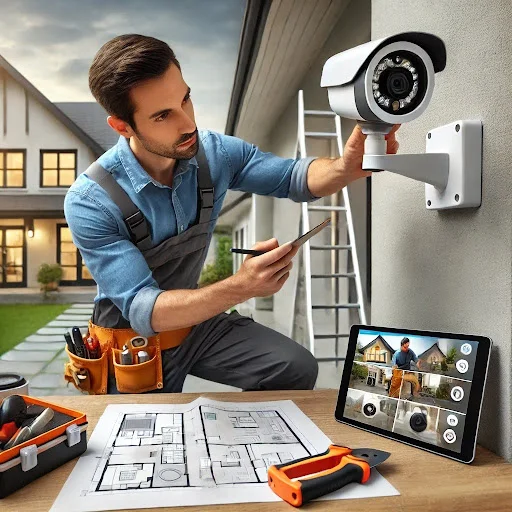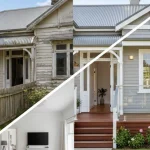We all want to sleep a little better at night knowing our place is locked down and protected, and a great way to feel protected is with security cameras. Security cameras have become one of the easiest and most effective ways to keep an eye on things, whether you’re at work, away on holiday, or just binge-watching Netflix from the couch.
But here’s the catch: just because you’ve got cameras doesn’t mean you’re covered. In fact, most people have no idea how many blind spots their camera setup leaves behind. These little gaps in your camera coverage can make all the difference between catching something dodgy on tape—or missing it completely.
Before we dive in, it’s worth noting that a lot of these blind spots can be avoided if you get help from experienced CCTV installers who know exactly where to place cameras based on your home’s layout. And if you’re building or renovating a house, it’s a great time to plan out proper surveillance camera systems that work with your space instead of around it.
So, let’s walk through the most common (and often surprising) security camera blind spots in modern homes—and how to fix them.
Side Gates and Narrow Walkways
You know that little side path between your house and the fence? Or that tiny gate no one ever uses unless they’re sneaking around? Yeah, that’s a major blind spot.
Because it’s not a main entry, a lot of people don’t think to point a camera there. But these are exactly the kinds of spots someone would use if they’re trying not to be seen.
How to fix it: Use a wide-angle camera to cover both the side path and gate area. Even better if it has motion detection and night vision—you’ll get alerts the second something moves out there.
Back Fence Corners
We all love a nice private backyard, where fences are tall and neighbours are chill. But tall fences also give intruders a place to climb over without being spotted. The back corners of your fence are a favourite blind spot—they’re usually out of view and easy to jump over.
How to fix it: Install a camera that points along the back fence line, especially toward corners or any tree overhangs. Bonus points if it’s elevated (like mounted on a shed or pergola) to give it a better view.
The Front Porch
Most people put a camera facing directly at the front door, which is great. But what about the area around the porch? Like the spot where someone could crouch down beside a wall or hide behind a column and make their way to a window?
These areas are often just out of frame, meaning someone could easily lurk there without being seen.
How to fix it: Instead of aiming your front door camera straight at the door, tilt it slightly to capture the full porch and immediate surroundings. If your porch has multiple sides, consider a second camera for full coverage.
Inside of The Garage
You probably have a camera watching your driveway or the front of your garage. But what about inside the garage?
It’s a space filled with valuables—tools, bikes, sometimes even entry to your house. And if someone manages to break in quietly through a side door or back panel, your exterior camera won’t catch a thing.
How to fix it: Add a basic indoor camera or motion sensor light inside the garage, especially near any internal access doors. You don’t need Hollywood-level surveillance, just a reliable view of what’s going on inside.
Second-Storey Windows
Most people assume upper-level windows are too hard to reach, so they don’t bother covering them. Unfortunately, that’s exactly what someone with a clever climbing plan is counting on.
Homes that back onto bushland, quiet alleyways, or even construction sites are especially at risk.
How to fix it: If your home has a second floor, consider a wide-view camera that can catch movement near windows or balconies. Alternatively, install motion-sensing lights on the upper levels to spook off anyone climbing where they shouldn’t be.
Sheds, Workshops, or Detached Garages
If you’ve got a shed in the backyard, a pool equipment area, or a workshop out the back, don’t assume your main cameras are catching what’s going on there. These standalone structures are often blind to the central system, especially if there’s no lighting.
How to fix it: Wireless battery-powered cameras are perfect for this. They don’t need power cables, and many work on Wi-Fi or cellular connections. Position them to see entry points and the path leading up to the structure.
Be Prepared
It’s not about being paranoid—it’s about being prepared. Security cameras are there to protect, but only if they’re set up correctly and smartly. The truth is, most blind spots aren’t obvious until something happens. By that point, it’s too late.
That’s why it’s always a good idea to walk around your property with fresh eyes. Pretend you’re a stranger looking for ways to sneak in. Where would you hide? What wouldn’t be seen?
Your security setup should be smart, not just stylish. And avoiding blind spots is one of the smartest moves you can make.
If all of this sounds like a headache to try and figure it out on your own, then contact a professional in your area. There are plenty of businesses that specialise in this field and can help design a CCTV system that works with your property’s layout.







